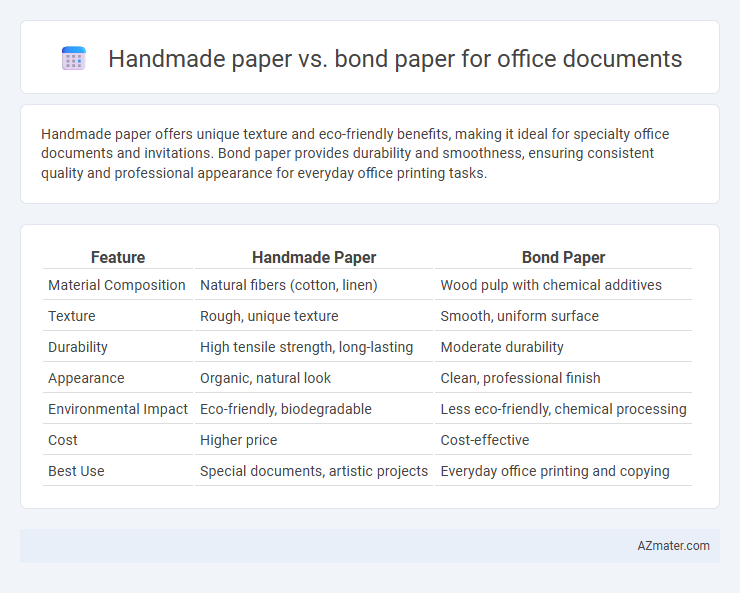Handmade paper offers unique texture and eco-friendly benefits, making it ideal for specialty office documents and invitations. Bond paper provides durability and smoothness, ensuring consistent quality and professional appearance for everyday office printing tasks.
Table of Comparison
| Feature | Handmade Paper | Bond Paper |
|---|---|---|
| Material Composition | Natural fibers (cotton, linen) | Wood pulp with chemical additives |
| Texture | Rough, unique texture | Smooth, uniform surface |
| Durability | High tensile strength, long-lasting | Moderate durability |
| Appearance | Organic, natural look | Clean, professional finish |
| Environmental Impact | Eco-friendly, biodegradable | Less eco-friendly, chemical processing |
| Cost | Higher price | Cost-effective |
| Best Use | Special documents, artistic projects | Everyday office printing and copying |
Introduction to Paper Types for Office Documents
Handmade paper, characterized by its textured surface and durability, offers a unique aesthetic often used for specialty office documents and certificates to convey elegance and authenticity. Bond paper, a widely used office paper type, provides smoothness, strength, and brightness ideal for everyday printing, copying, and official correspondence. Understanding the distinct properties of handmade versus bond paper helps in selecting the appropriate material based on document purpose, presentation quality, and durability requirements.
What is Handmade Paper?
Handmade paper is crafted from natural fibers such as cotton, hemp, or recycled materials through a manual process that produces unique textures and greater durability compared to machine-made papers. This type of paper is valued for its eco-friendly production, absorbency, and artistic appeal, making it ideal for special office documents or invitations that require a distinctive, tactile quality. Unlike bond paper, handmade paper often exhibits irregularities and natural fibers that enhance the aesthetic and sensory experience of printed materials.
What is Bond Paper?
Bond paper, a high-quality, durable writing surface made from wood pulp or cotton fibers, is widely used for office documents due to its smooth texture and excellent printability. It offers superior strength and resistance to wear, making it ideal for official letters, forms, and printer output. Unlike handmade paper, bond paper ensures uniformity, brightness, and compatibility with various ink and toner types common in office environments.
Texture and Appearance Comparison
Handmade paper features a unique, fibrous texture with irregularities that impart an artisanal, rustic appearance, ideal for formal invitations or artistic projects. Bond paper, commonly used in offices, offers a smooth, consistent texture with a clean, professional look suitable for everyday printing and official documents. The tactile contrast between handmade and bond paper significantly influences the visual impact and perceived quality of office documents.
Durability and Longevity
Handmade paper exhibits superior durability due to its natural fiber composition and absence of chemical coatings, providing enhanced resistance to tearing and aging. Bond paper, while smoother and ideal for printing, tends to be less durable over time because it contains bleaching agents and fillers that degrade faster under frequent handling. For long-term document preservation, handmade paper offers greater longevity, maintaining integrity and appearance much longer than standard bond paper.
Printing Compatibility and Performance
Handmade paper offers a unique texture and aesthetic appeal but may cause ink to bleed or smudge due to its uneven surface, making it less suitable for high-speed laser or inkjet printers commonly used in offices. Bond paper is engineered for compatibility with various printing technologies, ensuring crisp text and sharp images without ink absorption issues, leading to consistently professional document quality. Its smooth finish also supports faster printing speeds and reduced paper jams, enhancing overall office efficiency.
Environmental Impact and Sustainability
Handmade paper offers significant environmental benefits compared to bond paper, as it is typically produced using recycled fibers and natural materials without harmful chemicals, reducing pollution and waste. Bond paper manufacturing involves extensive use of energy, water, and chemical bleaching agents that contribute to deforestation and carbon emissions. Choosing handmade paper supports sustainability by conserving resources and promoting biodegradable, eco-friendly office document solutions.
Cost Analysis: Handmade vs Bond Paper
Handmade paper typically incurs higher costs due to labor-intensive production and limited availability compared to mass-produced bond paper, which is more economical for office document use. Bond paper offers consistent quality and affordability, making it the preferred choice for large volume printing and daily administrative tasks. While handmade paper provides unique texture and aesthetic value, its expense limits practicality for routine office documentation.
Suitability for Formal and Legal Documents
Handmade paper, characterized by its textured surface and unique fiber patterns, is less suitable for formal and legal documents due to potential issues with legibility and durability. Bond paper offers a smooth finish and high tensile strength, making it ideal for official documents that require clear printing, signatures, and long-term preservation. Legal offices and government agencies commonly prefer bond paper to ensure professional presentation and archival quality compliance.
Choosing the Best Paper for Your Office Needs
Handmade paper offers a unique texture and eco-friendly appeal, making it ideal for special presentations or branding materials, while bond paper is more durable, cost-effective, and suitable for everyday office documents due to its smooth finish and compatibility with printers. Choosing the best paper depends on balancing the need for professional appearance with practical factors such as print clarity, weight, brightness, and budget. For bulk printing and standard documentation, bond paper with 20-24 lb weight and 92-96 brightness provides optimal performance and cost efficiency.

Infographic: Handmade paper vs Bond paper for Office document
 azmater.com
azmater.com